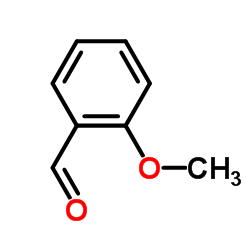o-Anisaldehyde

o-Anisaldehyde structure
|
Common Name | o-Anisaldehyde | ||
|---|---|---|---|---|
| CAS Number | 135-02-4 | Molecular Weight | 136.148 | |
| Density | 1.1±0.1 g/cm3 | Boiling Point | 243.5±0.0 °C at 760 mmHg | |
| Molecular Formula | C8H8O2 | Melting Point | 34-40 °C(lit.) | |
| MSDS | Chinese USA | Flash Point | 117.8±0.0 °C | |
| Symbol |

GHS07 |
Signal Word | Warning | |
|
3D-QSAR and molecular docking studies of benzaldehyde thiosemicarbazone, benzaldehyde, benzoic acid, and their derivatives as phenoloxidase inhibitors.
Bioorg. Med. Chem. 15 , 2006-15, (2007) Phenoloxidase (PO), also known as tyrosinase, is a key enzyme in insect development, responsible for catalyzing the hydroxylation of tyrosine into o-diphenols and the oxidation of o-diphenols into o-quinones. Inhibition of PO may provide a basis for novel env... |
|
|
Noncovalent immobilization of ionic-tagged box-Cu(OAc)2 complex and its application in asymmetric Henry reaction.
Chirality 24(12) , 1092-5, (2012) Immobilized Cu(OAc)(2)-bis(oxazolines) via hydrogen bonding by SBA-15 was applied to asymmetric Henry reaction, and good enantioselectivities were obtained (up to 83% ee) between 2-methoxybenzaldehyde and CH(3)NO(2) in isopropyl alcohol (iPrOH). The catalyst ... |
|
|
Food protective effects of Periploca sepium oil and its active component against stored food mites.
J. Food Prot. 75(1) , 118-22, (2012) The aim of this study was to examine the acaricidal activity of Periploca sepium oil and its active component against Tyrophagus putrescentiae. Based on its 50% lethal dose (LD(50) ) value, P. sepium oil (8.45 μg/cm(2)) was highly active against T. putrescent... |
|
|
Preparation, regulation and biological application of a Schiff base fluorescence probe.
Spectrochim. Acta. A. Mol. Biomol. Spectrosc. 153 , 1-5, (2015) A facile fluorescence switch with Schiff base units was designed and achieved by nucleophilic addition and dehydration reaction. The fluorescence of the probe can be regulated by metal ions (Al(3+) and Cu(2+)). The whole process shows that the weak fluorescen... |